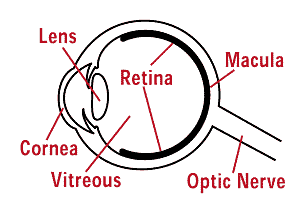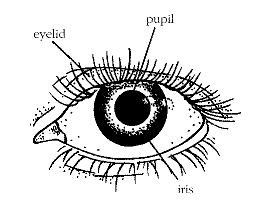General Information for Parents of Premature Babies About
Retinopathy of Prematurity
Retinopathy of prematurity (ROP for short) is an eye problem
seen in some premature babies. In babies with ROP the blood vessels
in the retina have developed abnormally after birth. Most premature
babies do not develop any ROP. In babies that do develop ROP it is
usually mild and goes away by itself, without causing any problems
with vision.
What is ROP?
ROP is a problem with the way the blood vessels develop on the
surface of the retina. (The retina is the layer at the back of the
eye that is like a film in a camera - see figure 1.) When a baby is
born prematurely these blood vessels are immature like the rest of
the baby. In most premature babies the retinal blood vessels grow
properly. In some premature infants the blood vessels start to grow
the wrong way. Instead of branching like a tree the vessels link up
side to side and in some cases grow away from the retina towards
the centre of the eye. The severity of ROP is graded from stage one
to stage five. Stage one is the mildest and stage five the most
severe.

Figure 1. Major parts of the eye.
Why do premature babies
get ROP?
We do not understand why some babies develop ROP and others do
not. Much research continues to be done to solve this mystery.
Serious ROP is very rarely seen in babies weighing more than 1,250
grams at birth. Many years ago ROP was more common and that was
linked to excessive use of oxygen. Now the supply of oxygen to
premature babies is very closely monitored and the amount of oxygen
given to your baby is very carefully calculated and controlled. As
a result ROP is less common but it still occurs. It is well known
that the sicker and smaller a baby is the more likely it is that
ROP will develop.
How will
I know if my baby is getting ROP?
We cannot predict which babies will develop ROP. All babies
weighing less than 1250 grams at birth will have regular eye
examinations after their gestational age reaches 30 to 31 weeks.
These examinations are undertaken by a medical eye specialist known
as an ophthalmologist. To look at the back of a baby's eyes the
pupil (black circle in the middle of the coloured part at the front
of the eye) needs to be dilated (see figure 2). Eye drops are used
to dilate the pupils. The examination only takes a couple of
minutes. Your baby may be minimally upset by these examinations and
will settle very quickly once the eyes have been checked.

Figure 2. Eye drops make the pupil larger so the retina can be
examined.
What is
the risk of my baby developing ROP that needs treatment?
The following table gives results for babies screened for ROP at
the neonatal nursery of the Royal Women's Hospital, Melbourne
between July 1992 and June 2002. These results will vary from
nursery to nursery and from time to time and are only intended to
be a guide to give some idea of the possibility of babies of
certain birth weights needing treatment. It is clear form this
table that most premature infants do not develop ROP severe enough
to warrant treatment.
Birth weight
|
Number of Babies
Screened
|
Number of babies with
ROP
That needed treatment
(%)
|
> 1250 g
|
245
|
0
|
1000 -1250 g
|
489
|
4 (0.8%)
|
750 - 999 g
|
425
|
15 (3.3%)
|
500 - 749 g
|
207
|
33 (16%)
|
< 500 g
|
20
|
5 (25%)
|
If my
baby has ROP, what happens?
In most babies ROP is mild and over a period of weeks the ROP
gradually disappears. The ophthalmologist will check your baby's
eyes every one or two weeks and you will be told the result of each
examination.
Can ROP be treated?
Yes, but remember very few babies develop ROP that is bad enough
to need treatment. At the Royal Women's, Melbourne only about 5 %
of babies checked for ROP actually need treatment. Mild ROP does
not need treatment as it almost always goes away by itself. If your
baby needs treatment this is called threshold disease (severe stage
three ROP). If your baby develops threshold ROP treatment options
will be discussed with you. The treatment is generally done with
laser and in 90% of babies needing treatment the ROP disappears and
sight is preserved.
If your baby may need treatment more information will be given
to you and you can discuss the situation with the paediatricians
and ophthalmologist caring for your baby.
Who can
I talk to about ROP?
The nurse or doctor taking care of your baby are always the
first people to ask. If they cannot answer your questions they will
arrange a time for you to discuss your baby's eye problems with the
ophthalmologist.
Will my
baby need to have eye checks after leaving hospital?
It is recommended that all babies who are small enough to have
their eyes checked while in hospital should be offered an eye
examination at one year of age. A small number of these children
are found to have turned eyes or need glasses for clearer vision,
even if they did not have any ROP while in hospital. It is strongly
recommended that you make sure your baby has an eye examination at
about one year of age. Depending on the finding at this check-up
further eye checks may be needed.
Remember ROP is treatable
Only some babies with birth weights less than 1250 grams develop
ROP and in most of these babies the ROP is mild and goes away
without treatment. Only a very few babies develop severe ROP and
treatment is successful in most cases.